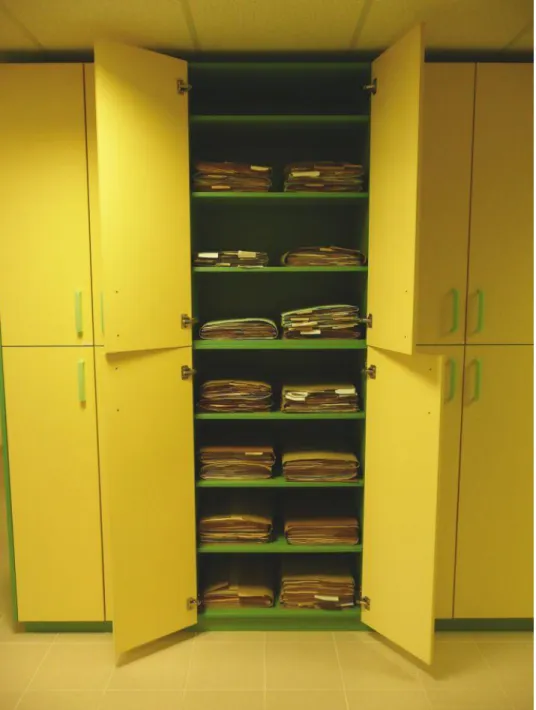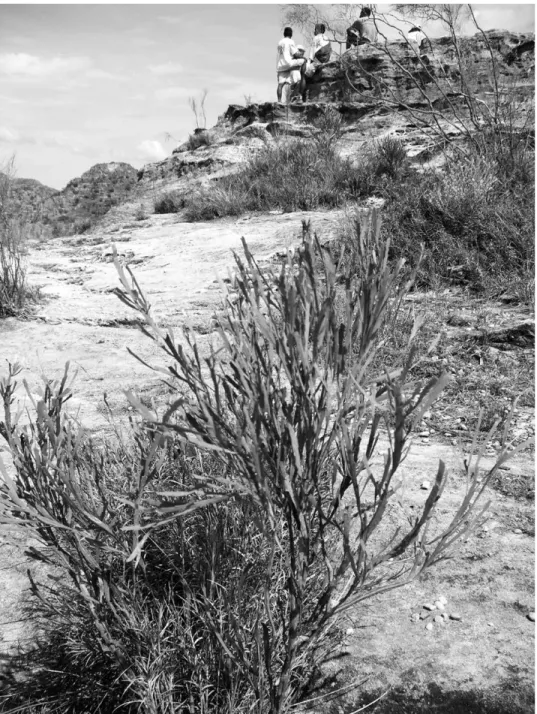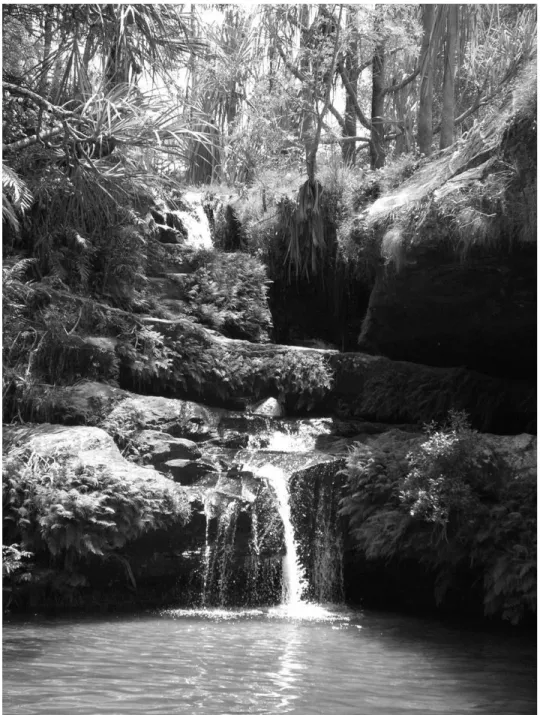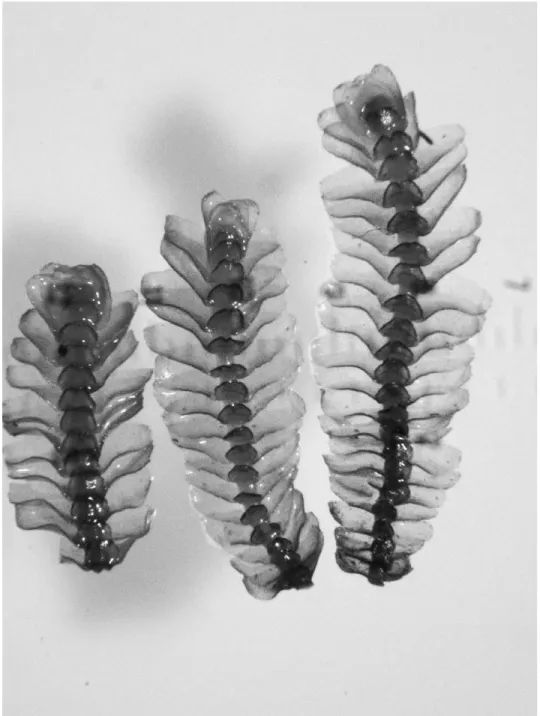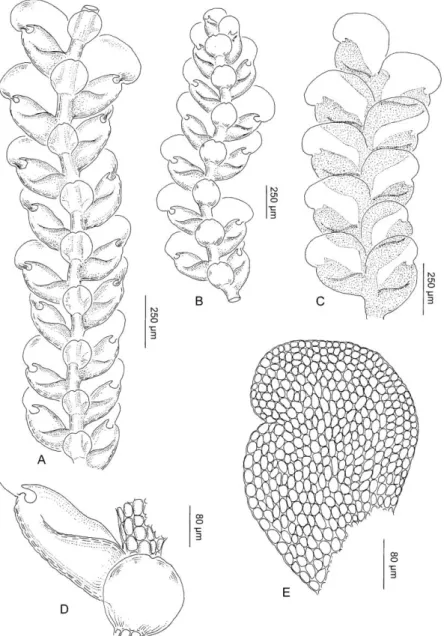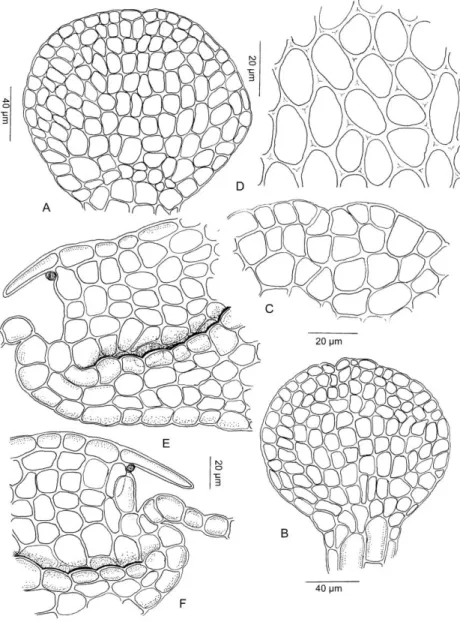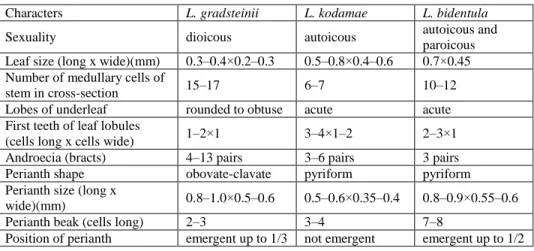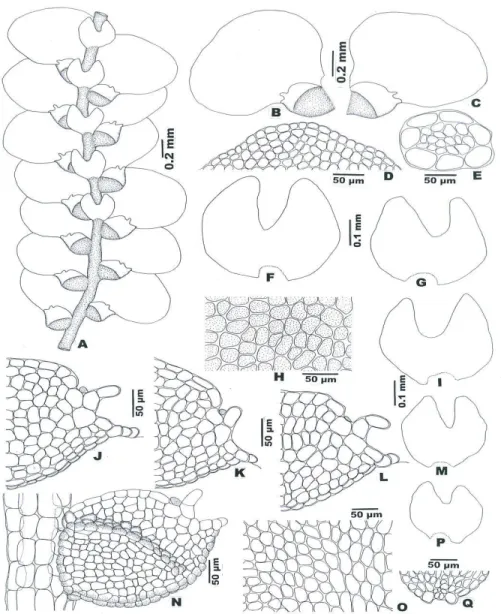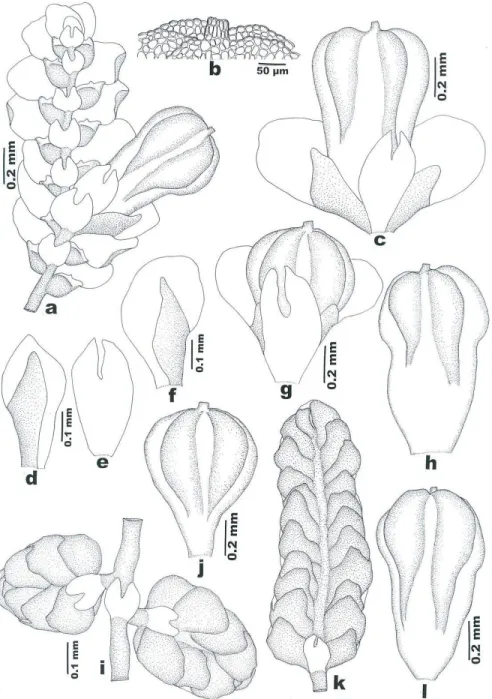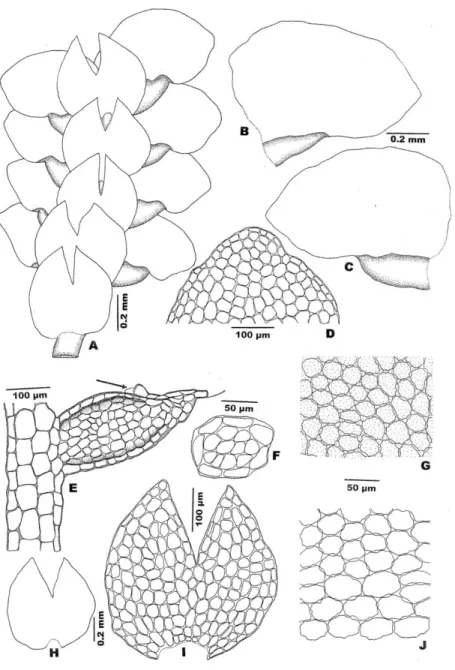ACTA
BIOLOGICA PLANTARUM AGRIENSIS
TOMUS 1.
REDIGIT
ERIKA PÉNZES-KÓNYA
ACTA BIOLOGICA PLANTARUM AGRIENSIS
(ABPA)
from Acta Academiae Paedagogicae Agriensis Sectio Biologiae
a Journal of Plant Biology
EDITOR
ERIKA PÉNZES-KÓNYA
EGER, 2010
Editor-in-Chief:
Tamás Pócs (Taxonomy) Senior Editors:
Sándor Orbán (Ecology) László Mustárdy (Cell Biology)
Endre Lehoczky (Biophysics)
Editorial Board:
Mária Papp (Anatomy)
Sándor Dulai (Physiology, Stress- and Ecophysiology) Marianna Marschall (Biochemistry, Stress and Ecophysiology)
István Molnár (Molecular Biology) Éva Darkó (Biotechnology) Márta Molnár-Láng (Genetics)
András Vojtkó (Geobotany)
Technical and Managing Editor:
Erika Pénzes-Kónya HU ISSN 2061-6716
Papers of this volume are available:
http://abpa.ektf.hu/
A kiadásért felelős
az Eszterházy Károly Főiskola rektora Megjelent az EKF Líceum Kiadó gondozásában
Kiadóvezető: Kis-Tóth Lajos Műszaki szerkesztő: Nagy Sándorné Megjelent: 2011. május Példányszám: 50 Készítette: az Eszterházy Károly Főiskola nyomdája
Felelős vezető: Kérészy László
ACTA BIOLOGICA PLANTARUM AGRIENSIS,
FROM ACTA ACADEMIAE AGRIENSIS SECTIO BIOLOGIAE, A JOURNAL OF PLANT BIOLOGY
The Acta Biologica Plantarum Agriensis a member of the Acta Academiae Paedagogicae Agriensis family of scientific journals, is published yearly by Eszterházy College and its Institute of Biology, Eger. This journal contributes in all areas of plant biology, including taxonomy, geobotany, anatomy, physiology, stress- and ecophysiology, biochemistry, biophysics, molecular biology, cell biology, genetics and ecology.
The printed version of Acta Biologica Plantarum Agriensis is published in Hungary, in Eger and published by Líceum Publisher Office, Eszterházy College.
Editor-in-Chief: Tamás Pócs professor emeritus, Dsc Eger Eszterházy College colura@chello.hu Senior Editors: Sándor Orbán,Eger
László Mustárdy, Szeged Endre Lehoczki, Szeged Editorial Board: Mária Papp, Debrecen
Sándor Dulai, Eger Marianna Marschall,Eger István Molnár, Martonvásár Éva Darkó Martonvásár
Márta Molnár-Láng, Martonvásár András Vojtkó, Eger
Manuscripts and other correspondence should be addressed to:
Managing Editor, Erika Pénzes-Kónya PhD konya@ektf.hu
Department of Botany, Eszterházy College PO Box 43 H-3301 Eger, Hungary
Facsimile: +36 36 520 446
The Notice to Authors is available from the web site of the journal http://abpa.ektf.hu
PREFACE
Let me greet you by the mediaeval saying: LECTURIS SALUTEM!
Our departments of Botany and of Plant Physiology have a long tradition in geobotanical, ecophysiological and cryptogam taxonomic research. Our herbarium with more than 200,000 specimens, especially rich in tropical bryophytes, has given opportunity for many researchers to study the Hungarian and the overseas floras. This has inspired our Editorial Board to establish an international English language publication forum for our researchers and anyone interested in these topics. There have already been attempts to form special sections like Sectio Biologiae, within the frame of more than 50 years old Acta Academiae Paedagogicae Agriensis, but it now seems practical to create a more independent and international botanical periodical, together with its internet version, the Acta Biologica Plantarum Agriensis, which is to be published once every year.
We kindly invite all members of the botanical community to send us manuscripts of international interest for publication. We will consider papers in any of the main areas of plant biology including anatomy, physiology, stress- and ecophysiology, biochemistry, biophysics, molecular biology, cell biology, genetics, ecology, taxonomy and geobotany. Deadlines for manuscripts for each year‟s issue is the end of April. The Editorial Board will send the manuscripts to adequate reviewers and will publish them, based on their opinion early next year, according to the possibilities.
We are grateful to the Faculty of Science and to the Liceum Kiadó Publisher of the Eszterházy College, Eger, for helping to accomplish our efforts.
Tamás Pócs, editor-in -chief professor emeritus Department of Botany Eszterházy College, Eger
THE HERBARIUM OF THE BOTANICAL DEPARTMENT IN KÁROLY ESZTERHÁZY COLLEGE (EGR)
Andrea Sass-Gyarmati and András Vojtkó
Botanical Department, Faculty of Science, Károly Eszterházy College, EGER 1. Short history of the Herbarium
Certain collections as well as the herbarium as a whole, because of their uniqueness, are indispensable to scientific study, and have become a valued part of our national heritage. Some collections are irreproducible while others are treasured for their comprehensiveness – covering certain areas or complete taxonomic groups. The Eger herbarium also includes one of the largest cryptogamic collections in Central Europe.
The Botanical Department was founded in 1949, by Tibor Hortobágyi, a prominent Hungarian algae researcher. This course of development was followed under the direction of Tamás Pócs, appointed in 1961, who founded the herbarium with his fern, lichen, bryophyte and vascular plant collections. A year later János Suba joined the department, who obtained for the Herbarium the Márton Vrabélyi vascular collection, previously preserved at Dobó István Jesuitical Secondary School. This valuable collection includes 19th century source material of the flora of Bükk and Mátra mountains from Vrabélyi‟s own collections as well as exchange material from prominent botanists (Haynald, Holuby, Janka, Kerner, Vágner, etc…) of the time.
In 1963 and 1965-66, owing to its Vietnam partnership the College received tropical material in larger amounts for the first time, collected by Tamás Pócs.
From the 60‟s a more rapid development of the collections can be observed. The herbarium now incorporated its staff‟s own collection of vascular and non- vascular material from Northern Hungary and the Carpathians. The college provided significant funds for the Department to purchase herbarium materials as well literature. This is how bryophyte collections of Árpád Károlyi and László Vajda and Ferenc Fóriss‟s comprehensive lichen herbarium, as well as the majority Ádám Boros‟s professional library could be obtained. It also allowed for smaller contributions to the travels of Dénes Balázs geographer in exchange for valuable bryophyte collections from around the world. The herbarium also
collected by György Topál and from Papua New Guinea collected by János Balogh (both zoologists).
To date the herbarium includes contributions from 210 botanists and incorporates 10000 vascular, 8000 lichen and 200000 bryophyte specimens. It cultivates active partnership with many herbaria of the world. Specialists of various taxa from abroad and Hungary frequently visit the herbarium to study unrevised material. Maintaining the main profile the cryptogamic collection has become the largest within the herbarium. Specimens from all around the world can be found in the bryophyte collection with remarkable collections by the staff on expeditions in East Africa, Tunisia, the Indian Ocean islands, Australia, Cuba, Venezuela, Vietnam, the Fiji Islands and other territories.
From within the Carpathian basin the collection of the cryprogamic vegetation of loess cliffs is unique in its comprehensiveness. Vascular and cryptogamic plants were both collected in different areas of Hungary: Őrség, the Bükk and Mátra mountains; and from the Carpathians: the Lower Tatra, Bihar, Retezát, Hargita,, Tarcu, Parâng and Fogaras mountains. We also preserve material from outside the Carpathians: from the Julian Alps, the Spitzbergen, Greece and Bulgaria.
We aim to assemble comprehensive compilations of various taxa in our special collections like the Calymperaceae family, ordo Hookeriales, from the genera of Fissidens, Colura, Cololejeunea, Lejeunea, Lopholejeunea and Frullania. to make their revisions possible.
Lichen specimens have also been collected all over Hungary. We also have a considerable tropical collection from Kenya, Tanzania, Indian Ocean Islands, Ruanda, Argentina, Brasil, Vietnam, Australia, and the Fiji Islands.
A database of lichen collections (ISIS 2.3) and an update of bryophyte types has been developed.
2. International Relations
Our Herbarium operates within the international network of herbaria. We exchange material with more than 60 herbaria worldwide. Numerous exssicata series are preserved a list of which is appended below. Our type material of over 500 specimens is recognised and cited worldwide. We lay great emphasis on the development and maintenance of our academic library, assembling periodicals, biogeographical publications, flora works and coenological works among which rarities can also be found.
The Hungarian National Office of Cultural Heritage declared the Eger College Herbarium protected in 2007 (resolution no. 401/0055/004/2007). Since the declaration the most important development has been the relocation of the cryptogamic collection in one of the buildings of Eszterházy College Faculty of Science. The two spacious state-of-the-arts-halls are adjoined by two research rooms equipped with microscopes, computers and a cryptogamic library facilitating the study, revision and exchange of materials (formerly stored in five separate locations). The new facilities allow the labelling and integration of the large amounts of previously identified material making it possible to send them out to the specialists concerned for revision.
Fig.2. The European bryophyte collection
Fig. 2. One open cupboerd in the overseas hepatic collection
3. List of Exsiccata or their parts preserved in the Herbarium of the Botanical Department of Eszterházy College, Eger (EGR):
Bryophyta Africana Selecta. Ed. R. Ochyra and T. Pócs
Bryophyta Arctica exsiccata. Ed. W. C. Steere and Kjeld A. Holmen Bryophyta Exsiccata Generis Plagiochilae. Ed. J. Heinrichs & H. Anton Bryophyta Exsiccata. Z. Iwatsuki and M. Mizutani
Bryophyta Hawaiica Exsiccata. Ed. W.J.Hoe Bryophyta Neotropica Exsiccata. Ed. S.R. Gradstein Bryophyta Selecta Exsiccata. Ed. H. Inoue
Bryophyta Vogesiaca Exsiccata. Ed. J.-P. Frahm Bryophytes of Asia. Ed. H. Deguchi & T. Yamaguchi Bryophytes of Asia. Ed. Z. Iwatsuki & M.. Higuchi Bryophytes of South China. Ed. B.J. Lin & L. Zhang Bryophytorum Typorum Exsiccata. Ed. W.R. Buck.
Bryotheca Brasiliensis. Ed. E. Ule
Bryotheca Europaea. Ed. Rabenhorst, Winter Bryotheca Gottingensis. Ed. I. Holz & J. Heinrichs.
Bryotheca Polonica. Ed. S. Lisowski Kraków, 1954 Camylopodes Centrali-Africanae. Ed. J.-P. Frahm Camylopodes Peruvianae Exsiccatae. Ed. J.-P. Frahm
Collection of Juncaceae, Cyperaceae, Typhaceae and Sparganiaceae. Ed. Á.
Dégen
Cryptogamas exsiccatas. Ed. F. Petrak Fontinalaceae Exsiccatae. Ed. B. Allen
Hepaticae et Musci URSS exsiccati. Ed. I. Abramov
Hepaticae et Musci URSS exsiccati. Ed. L.I. Savicz-Ljubitzkaja Hepaticae Europeae Exsiccatae. Ed. V. Schiffner
Hepaticae Exsiccatae S.O.Lindbergii. Ed. S. Piipo Hepaticae Japonicae Exsiccatae. Ed. S. Hattori
Hepaticae macroregioni meridionali Poloniae exsiccati. Ed. K. Jedrzejko, H.
Klama, A. Stebel, J. Arnowiec
Hepaticae macroregioni meridionali Poloniae exsiccati. Liverworts of Southern Poland. Ed. K. Jedrzejko
Hepaticae macroregioni meridionali Poloniae exsiccati. Mosses of Southern Poland. Ed. K. Jedrzejko
Herbier Bryologique. Ed. J.L. De Sloover Iter Indicum 1839/94. Ed. V. Schiffner Moss exsiccati. Ed. T.C.Frye
Musci Australasiae Exsiccati. Ed. H. Streimann
Musci et Hep. Novae Caledoniae Exsiccati. Ed. I. Thériot
Musci Frondosi Archipelagici Indici. Ed. M. Fleischer
Musci japonici Exsiccati. Ed. Z. Iwatsuki and A. Nouchi & S. Hattori Musci Turkestanici. Ed. V.F.Brotherus
Societé d’Échange des Muscinées (S.E.M.)
Sphagotheca Boreali-Americana. Ed. R.E. Andrus and D.H.Vitt Svenska Pacific Expeditionen 1917-17. Ed. Carlo Inga Skottsberg
Flora exsiccata Austro-Hungarica, a Museo universitatis Vindobonensis edita Flora Hungarica exsiccata, a sectione botanica Musei Nationalis Hungarici
edita
Lichenes Bükkenes Exsiccati. Ed. F. Fóriss
Lichenes Regni Hungarici Exsiccati. Ed. Ö. Szatala Lichenes saxonici exsiccati. Ed. Schade, Stolle & Riehmer
Lichenes Selecti Exsiccati. Editi ab Instituto Botanico Academiae Scientiarum Cechoslovacae, Pruhonice prope Pragam. Ed. A. Vêzda
Lichenotheca Rossica Exsiccata. Ed. P. Savicz Plantae Exsiccatae Carpatorum. Ed. A. Margittai Plantae Hungariae Exsiccatae. Ed. Á. Boros Plantae Hungariae Exsiccatae. Ed. Dr. Á. Dégen
4. Publications on the Eger Herbarium:
Kis G. (2004): Non European Bryophyta types and list of exsiccata int he Eger Cryptogamic Herbarium (EGR). Folia Hist. nat. Mus. Matr. 28: 5–52.
Kis G., Pócs T. & Szabó A. (2000): Az Eszterházy Károly Főiskola Növénygyűj- teményei. Magyar Tudomány Napja ‟99. Konferencia előadásainak össze- foglalói. EKF Biológia és Környezettudományi Intézet, Eger. pp. 40–41.
Molnár K. (2004): Lichen types and list of exsiccata int he Eger Cryptogamic Herbarium (EGR). Folia Hist. nat. Mus. Matr. 28: 53–55.
Nagy I. & Papp S. (1965): Az Egri Tanárképző Főiskola herbáriuma – Bot.
Közlem. 52: 157–159.
Ochyra R. & Pócs T. (1992): Bryophyta Africana Selecta. Series I-IV. Number 101-200. (Schaedae of Exsiccata) Kraków, 4 x 7 pp.
Ochyra R. & Pócs T. (1993): Bryophyta Africana Selecta. A new exsicata from Africa. Fragm. Flor. Geobot. 37 (2): 379–388. Kraków.
Ochyra R. & Pócs T. (1993): Bryophyta Africana Selecta. Centuria II. Fragm.
Flor. Geobot. 39(1): 129–135. Kraków.
Ochyra R. & Pócs T. (1993): Bryophyta Africana Selecta. Series V–VIII.
Number 1–100. (Schaedae of Exsiccata) Kraków, 4 x 7 pp.
Pócs T. (1976–1977): Type catalogue of the Bryophyte Herbarium of Ho Si Minh Teacher‟s College, Eger, Hungary. Folia Hist. nat. Mus. Matr. 4: 15–36.
Pócs T. (2000): Botanikai kutatások 50 esztendeje az Egri Tanárképző Főiskola Növénytani Tanszékén. Magyar Tudomány Napja ‟99. Konferencia elő-
adásainak összefoglalói. EKF Biológia és Környezettudományi Intézet, Eger. pp. 34–36.
Pócs, T. (2005): Activities in tropical bryology at the Eszterházy College, Eger, Hungary (EGR) during 2004–2005. Bryol. Times 116: 6
A. Sass-Gyarmati A., K. Molnár K, A. Vojtkó A. and S. Dulai S. (2010):
Bryophyte and lichen species collected by Antal Margittai found int he Herbarium of Eger (EGR). A Kárpátok növényzetének vizsgálata az elmúlt kétszáz évben. Proceedings, 220–226 p. Mukacevo-Beregovo, Ukraine.
Suba J. (1981): Emlékezés Vrabélyi Mártonra, Heves megye nagy flóra- kutatójára. Folia Hist. nat. Mus. Matr. 7: 11–14.
Vojtkó A. (1996): Vrabélyi Márton bükk-hegységi gyűjtései az egri Növénytani Tanszék herbáriuma alapján. – Bot. Közl. 83: 170.
BAZZANIA ORBANII (LEPIDOZIACEAE), A NEW SPECIES FROM MADAGASCAR.
EAST AFRICAN BRYOPHYTES, XXVIII.
Tamás Pócs
Eszterházy College, Department of Botany, Eger, Pf. 43, H-3301, Hungary;
phone: (36)-36-434-685, e-mail: colura@chello.hu Bazzania orbanii from Madagascar
Key words: Bazzania, endemism, Isalo National park, Lepidoziaceae, Madagascar
Abstract: A new species of Bazzania is described from Isalo National Park in the Toliara Province of south central Madagascar. The new species was collected from a very isolated wet spot of the otherwise dry area, notorious for its endemic succulent plants. The new species differs from all known African taxa by its recurved underleaf margin consisting of elongate cells with incrassate, brownish walls.
Introduction
Members of the Botany Department of Eszterházy College (Eger) participated in a collecting expedition organized by Missouri Botanical Garden in Madagascar, during September and early October of 1994, to investigate the bryological diversity of the island. One group of them, Sándor Orbán, András Szabó and András Vojtkó, visited the dry southeast part of the island, poor in bryophytes. But even in this area there are small pockets of ecologically different habitats. Such was the so called “Piscine Naturelle” in the otherwise dry, rocky Isalo Natonal Park, where a brook, leading through a sandstone gorge in a depression forms this natural pool surrounded by a riverine forest large specimens of Pandanus pulcher(plates I–II). On the shady rocks and soil of the banks some ferns and bryophytes are abundant, like Calypogeia longifolia Steph. (Pócs 2005). At this place collected S. Orbán also a sample of Bazzania which is peculiar for the first sight, having recurved underleaf margins, which are conspicuous under dissecting microscope, also by their brown colour (see plate III). Jones (1975) in his revision of African Bazzania discusses in details
has recurved margin of the aphigastria with incrassate, brownish cell walls. On this base the Madagascar plant collected at the “Piscine Naturelle” of Isalo National Park is described as new to science.
Description of the new species
Bazzania orbanii Pócs, sp. nov. (Figs. 4: 1 and 3-7; 5)
Differt a Bazzania decresente (Lehm. et Lindenb.) Trevis marginibus recurvis amphigastrii et a B. recurvolimbata (Steph.) Kitagawa parietibus incrassatis et brunneis cellularum marginis amphigastrii.
Typus: SW Madagascar, Toliara Province, Isalo National Park, “Piscine naturelle”, a deep pool of a brook in a sandstone gorge, shaded by Pandanus pulcher trees, at 800 m alt., under overhanging streambank rocks, on soil. Coll.
S. Orbán, 9455/J (Holotype EGR, Isotypes MO, TANA).
Pale green, weft forming plant with 10-20 mm long, slightly branching, 1.5 mm wide, in dry state quite julaceous shoots. Stem 250 μm thick, medullary cells in about 8 layers and evenly incrassated walls. Flagelliform vertical intercalary branches 3–5 mm long, 150 μm thick. Side leaves falcato-ovate, imbricate, 700–750×480–500 μm, in dry state incurved, with rounded or slightly 1–3 apiculate apex. Cells with nodulose trigones, at the leaf apex with incrassate walls. Apical cells 10–28 x 10–20, the median 30–35×25–28 and the basal ones 30–50×25–30 μm in size. Underleaves imbricate or contiguous, reniform oval, wider than long, 250–300×350–460 μm, with rounded or sunuose-truncate or seldom slightly bilobed apex and with partly or wholly recurved margin.
Marginal cells elongated parallel to the margin, 25–32×15–20 μm, with strongly and evenly incrassate, brown tinged walls, in 1–4 rows without chloroplasts. The other cells are similar to those of the side leaves. Sterile.
Etymology: It is named after its collector, prof. Sándor Orbán, renowned bryologist.
Discussion
Bazzania orbanii is a member of Sectio Connatae (Steph.) Fulford and seems to be related to the widespread Bazzania decrescens (Lehm. et Lindenb.) Trevis, which is a very polymorphic taxon (Jones 1975, Grolle 1995). Especially in Madagascar and in the neighbouring islands several uncertain taxa of this group were already described, which badly need revision. There are some small sized forms of Bazzania decrescens with entire leaves and underleaves, collected at many localities, also in Isalo National Park, which can be compared with the new species (see fig. 1: 2). Anyhow, none of them has this peculiar
amphigastrial margin, on which base the species easily can be separated. Similar recurved underleaf margin is observed in certain Asian species, like in Bazzania recurvolimbata (Steph.) Kitagawa of Thailand and Vietnam (Kitagawa 1967, Pócs 1969). It differs even from this species by its thick, brown walled marginal underleaf cells, which are in B. recurvolimbata hyaline and thin walled. The generally dry and very rocky Isalo National Park have several endemic species, both in the xeric habitats (e.g. the succulent Adenia isaloensis, Aloe isaloensis, Euphorbia primulifolia var. begardii, Pachypodium rosulatum ssp. gracilius and a legume with phyllocladia, Mundulea phylloxylon, according to Rauh 1995) and in the gorges with permanent running water (Ravenea rivularis, a tall palm tree, see Dransfield & Beentje, 1995). The new Bazzania species seems to be a nice addition to these Isalo endemics.
Acknowledgements
The Author is grateful to the National Geographic Society, USA (Grants No.
5201/94, to the Hungarian Academy of Sciences and to the Hungarian Scientific Research Fund OTKA (Grant No. T 038319) for sponsoring and to Dr. Robert E.
Magill (MO) for organizing the Madagascar expedition, finally to Prof. Sándor Orbán to place at his disposal the Bazzania specimen.
References
Dransfield, J. & Beentje, H. (1995). The Palms of Madagascar. Royal Botanic Gardens, Kew.
Grolle, R. (1995). The Hepaticae and Anthocerotae of the East African Islands.
An annotated catalogue. Bryophytorum Bibliotheca 48: 1–178.
Jones, E.W. (1975). African Hepatics XXVII. Bazzania. Journal of Bryology 8:
299–316.
Kitagawa, N. (1967). Studies on the Hepaticae of Thailand. I. The genus Bazzania, with general introduction. The Journal of the Hattori Botanical Laboratory 30: 249–270.
Pócs, T. (1969). A short survey of the Bazzania of North Viet-Nam. The Journal of the Hattori Botanical Laboratory 32: 79–94 + 204.
Pócs, T. (2006). East African Bryophytes, XX. Observations on some Calypogeiaceae . Acta Academiae Paedagogicae Agriensis, Nov. Ser., Sectio Biologiae 25: 29–35.
Rauh, W. (1995). Succulent and Xerophytic Plants of Madagascar, I. Strawberry Press, Mill Valley.
Fig. 1: Dry rock vegetation in Isalo National Park with Mundulea phylloxylon (Fabaceae) in the foreground. (Photo by S. C. Kozma)
Fig. 2: The “Piscine Naturelle” in Isalo National Park. (Photo by S. C. Kozma)
Fig. 3: The habit of Bazzania orbanii sp. nov. (Photo by T. Pócs)
Fig.4. 1 and 3-7: Bazzania orbanii Pócs, drawn from the type, Orbán 9455/J. 2: Small forms of Bazzania decrescens (Lehm. & Lindenb.) Trev. collected by Orbán, 9456/C and
F, also from the area of Isalo National Park, in the sandstone gorge high above the
“Piscine Naturelle”, under shady sandstone cliffs.
1-2: Habit. 3: leaves. 4: Median, 5: basal, 6: apical and 7: marginal leaf cells.
Fig.5. Bazzania orbanii Pócs, drawn from the type. 8: Underleaves. 9: Stem section. 10:
Marginal, 11: median and 12: apical underleaf cells.
CHEILOLEJEUNEA ULUGURICA (LEJEUNEACEAE, MARCHANTIOPHYTA),
A NEW SPECIES FROMTANZANIA
Itambo Malombe1, Eberhard Fischer2 and Tamás Pócs3
1National Museums of Kenya, East African Herbarium, P.O. Box 45166 00100 Nairobi, Kenya, imalombe@museums.or.ke; 2Institute for Integrated Natural Sciences, Dept. of Biology, University of Koblenz-Landau, Universitätsstr. 1 56070 Koblenz Germany, efischer@uni-koblenz.de; 3Eszterházy College,
Department of Botany, Eger,Pf. 43, Hungary, H-3301; colura@chello.hu Validation of Cheilolejeunea ulugurica
Cheilolejeunea, conservation, Eastern Arc, endemism, Uluguru, Tanzania Abstract
Cheilolejeunea ulugurica Malombe, Eb.Fisch. & Pócs is a new species affiliated to subg. Cheilolejeunea. One of its closest relatives seems to be Cheilolejeunea chenii from Asia. It is described from the Uluguru Mountains, members of the crystalline Eastern Arc of Tanzania, notorious for its richness in endemic species.
Introduction
Tamás Pócs presumed the possibility of a new species collected by him with his son Bence on the Bondwa peak of Uluguru Mountains in Tanzania in 1985.
The two other authors studied carefully the scanty material and confirmed his assumption, describing and illustrating this species. In an account on some new Cheilolejeunea species Malombe (2009) mentioned the name of Cheilolejeunea ulugurica Malombe, Eb. Fisch. et Pócs and published its detailed illustration with some annotation but without a diagnosis and a detailed description, referring to a paper of the three authors to be published later. The present paper will validate the new species, adding the necessary details.
The new species of Cheilolejeunea (Spruce) Schiffn. is described on the basis of the following morphological characters: the obovato-spathulate nature of the lobe with a lobule occupying its ⅔ to ¾ length with strongly incurved keel apex,
circumscription of the species from other allied members of subg.
Cheilolejeunea, especially of the closely related Asian Ch. chenii is provided, with some remarks on its ecology and conservation status.
Cheilolejeunea ulugurica Malombe, Eb. Fisch. et Pócs, sp. nov. (Fig. 1, 2) Differt a Cheilolejeunea chenii R.L. Zhu & M.L. So foliis falcatis angulis acutioribus inter carina et apice lobi, lobulis angustioribus marginibus liberis cellulis pluribus et marginibus distalibus solum 2-3 cellulis composita.
Typus : TANZANIA, Uluguru Mts, N side of Bondwa peak, 1650–1880 m, 26 Dec. 1985, B. & T. Pócs, 8565/S, (Holotype: EGR, microslide!).
Description
Plants green in situ turning brown in herbarium, up to 12 mm long. Shoots always mixed with other species, 560–776 µm wide, with few seldom branches.
Stem 64–84µm in diameter. Ventral merophytes of the stem 2 cells (31.5 × 21.7µm in average) wide. Leaves usually imbricate, obovato-spathulate, slightly falcate, spreading from the stem at an angle of 80–130o, 378–488 µm long, 340–
392 µm wide, apex broadly rounded, plane, bends outwards, margin smooth, base flat, running parallel along the central line of the stem. Lobe cell walls slightly thickened, usually with reduced mammillae, trigones very small, triangular, up to 2.6 µm in length, mid cells hexagonal, 32–64 µm long and 22.4–27.2 µm wide, marginal cells rectangular, 20.0–2.6 µm long and 16–32 µm wide. Lobule large, usually over 2/3 (up to ¾) of the lobe length, elongate, antical free margin flattened, bordered by ca. 10 cells. A strongly conspicuous fold which runs diagonally to nearly the entire length of the lobule to join the much incurved keel apex. The keel forms a very narrow sinus (<45o) with postical lobe margin. The distal lobule apex only 2-3 cells wide, truncate, except for the mid cell which sometimes tends to bulge. Apical tooth usually incurved to form a club-like appendage with the incurved keel side, rarely straight, 64–
105 µm long, spiniform. Hyaline papilla small, obovate, distal, at the very base of apical tooth. Underleaves distant, appressed completely to the stem, transversely inserted, orbicular, 304–488×336–484 µm, with sometimes slightly decurrent base and very shallow sinus as to appear like a notch, maximum 0.08 times the length of the underleaves or completely absent. Gametangia and vegetative reproductive organs not seen.
Ecology, distribution and conservation
Ramicolous on ericaceous stems at the edge of montane forest in Uluguru Mountains between 1650 to 1800 m altitude. It appears endemic to the locality
as no other material has been collected elsewhere despite intensive bryological explorations in the Eastern Arc Mountains. The Eastern Arc Mountains are notorious for their richness in endemics and in species common with Madagascar and the other Indian Ocean islands. From the 500 bryophytes known from Uluguru Mountains 8 species are narrow endemics, 10 species are restricted to the Eastern Arc and 40 are shared between the Eastern Arc and Indian Ocean islands (Pócs 1999, 2000). These elements are concentrated in the montane forest belt of this crystalline arc. This habitat is highly endangered owing to deforestation. The narrow forested ridge and plateau of Uluguru Mountains above 1400 m level, with its high diversity of cryptogamic and vascular plants and in animal life as well, deserves better protection.
Circumscription from other associated species
Cheilolejeunea ulugurica belongs to the subgen. Cheilolejeunea (Spr.) Schiffn. (Schuster, 1992) owing to its small size, its unicellular, spiniform apical tooth of lobule and flattened lobes (Zhu, So & Wang, 2002). The new taxon is closest to the Asian Ch. chenii R.L. Zhu & M.L. So, which is a rare species occurring only in southern China (Fujian and Taiwan). Cheilolejeunea ulugurica however differs from this species by having a longer and narrower lobule, which forms a narrow sinus with postical lobe margin. Also the free margin of the lobule is flat, bordered by about 10 elongated cells (7–8 in Ch. chenii). The truncate lobule apex is only 2–3 cells wide (6–8 cells wide in Ch. chenii). The inner base of lobule forms a conspicuous fold (which can be mistaken to a vitta) running diagonally towards the apex almost to join the keel.
Figure 1. Cheilolejeunea ulugurica A, B. Part of shoot, ventral view. C. Part of shoot, dorsal view. D. Lobule with underleaf. E. Leaf, dorsal view. Drawn from the holotype by
E. Fischer.
Figure 2. Cheilolejeunea ulugurica. A, B. Underleaves. C. Apex of underleaf. D. Cells from mid-lobe. E, F. Details of lobule. Drawn from the holotype by E. Fischer.
Acknowledgement
The first author kindly recognizes the financial support for the studies by the German Ministry of Education and Research (BMBF) within the BIOTA East Project E 04 (LC0625C1).
References
Malombe, I. (2009): Studies on African Cheilolejeunea (Lejeuneaceae) I: New species and new combinations. Acta Bot. Hung. 51: 315–328.
Pócs, T. (1999): Bryophyte speciation and diversity in the East African mountains. Bryobrothera 5: 237–245.
Pócs, T. (2000-'1998'): Bryophyte diversity along the Eastern Arc. J. East African Nat.Hist. 87: 75–84.
Schiffner, V. (1895). Hepaticae, In: A. Engler & K. Prantl, Die Natürlichen Pflanzenfamilien. Leipzig: Engelmann.
Schuster, R.M. (1992). The oil bodies of the Hepaticae. II. Lejeuneaceae. Journ.
Hattori Bot. Lab. 72: 163–359.
Zhu, R.-L., So, M.L. & Wang, Y.-F. (2002). The Genus Cheilolejeunea (Hepaticae, Lejeuneaceae) in China. Nova Hedwigia. 75: 387–408.
Zhu, R.-L., So, M.L., Cao, T. (1999): Neurolejeunea fukiensis belongs to Cheilolejeunea (Lejeuneaceae, Hepaticae). Taxon 48: 663–666.
LEJEUNEA GRADSTEINII (LEJEUNEACEAE), A NEW LIVERWORT SPECIES FROM MT . KINABALU, SABAH
Lee G. E.1, T. Pócs2, A. Damanhuri1 & A. Latiff1
1 School of Environmental and Natural Resource Sciences, Faculty of Science and Technology,
Universiti Kebangsaan Malaysia, 43600, Selangor, Malaysia
2 Botany Department of Eszterházy College, EGER, Pf. 43. H-3301, Hungary 3301
Lejeunea gradsteinii sp. nov.
Lejeunea, endemics, Malaysia, Marchantiophyta, Mt. Kinabalu
Abstract: Lejeunea gradsteinii is described and illustrated as a new species from Mt. Kinabalu, Sabah. The plant stands out by 1) lobules with flat free margin and 2 teeth, the first tooth consisting of (1)-2 cells, 2) whitish-green plant color, 3) weakly crenulate margins of leaves, underleaves, female bracts and bracteoles, 4) basal cells of leaf lobes forming a weak vitta, 5) well-developed trigones and scarce intermediate thickenings, 6) deeply bifid underleaves (to 2/3) with rounded tips, 7) long male shoots with up to 13 pair of bracts, and 8) long- exserted, obovate-clavate perianths with 5 sharp keels ending into short auricles.
Lejeunea gradsteinii is most closely related to L. kodamae Ikegami et Inoue and L. bidentula Herzog, all of which have 2-toothed lobules.
Introduction
A whitish Lejeunea species with two teeth on the leaf lobule, one very distinct and the other weakly developed, was found on Mt. Kinabalu, Sabah, in the course of the ongoing revision of the genus Lejeunea (Marchantiophyta:
Lejeuneaceae) in Malaysia (Lee et al. 2011a, 2011b). By the characteristic 2- toothed, never-reduced lobule the species did not match any of the Malaysian Lejeunea species studied thus far, all which have lobules with only one tooth and often being reduced. A 2-toothed lobule is otherwise also known only among Asian Lejeuneas in Lejeunea kodamae Ikegami et Inoue (Inoue 1961) and L.
bidentula Herzog (Herzog 1930), and in some members of Papillolejeunea Pócs (see below). However, none of these matched the species from Mt Kinabalu.
Other characteristic features of the species from Mt Kinabalu were the deeply
Papillolejeunea Pócs (Pócs 1997; this genus was reduced by Schuster 1998 to a subgenus of Lejeunea [as Lejeunea subg. Papillolejeunea (Pócs) Schust.]). In his treatment of Papillolejeunea, Pócs (1997:1), he mentioned, “The striking feature of the plant [Papillolejeunea] is the special development of first (distal) lobule tooth, which is papilliform, elongate, with blunt apex, consisting of two cells and standing perpendicular to the free lobe margin which is usually involuted with the blunt second (proximal) tooth.” However, the plant from Mt. Kinabalu differed essentially by the flat free margin of the leaf lobule, which was not involuted with the second tooth.
Since none of the described species of Lejeunea match our plant from Mt.
Kinabalu, it is described here as a new species. The species is named in the honor of Prof. Dr. S. Robbert Gradstein, who is the expert of the Lejeuneaceae family and has encouraged our study of the genus Lejeunea in Malaysia.
Description
Lejeunea gradsteinii G.E. Lee, A. Damanhuri & A. Latiff sp. nov. (Figs.
1,2)
Planta dioica, lobuli bidentati, amphigastria usque ad 2/3 bifida lobis obtusis.
Type: Malaysia, Sabah, Mt. Kinabalu, trail from Mempening shelter to Layang-Layang staff quarters, montane forest, on tree trunk, 2500-2800 m alt., 12 November 2010, G.E. Lee 1891 (holotype, UKMB; isotype, PC). Ibid., G.E.
Lee 1884, 1885, 1886, 1887, 1888, 1889, 1890 (paratypes, UKMB).
Plants dioicous, 1.3–1.4 mm wide, whitish green in the field, irregularly and densely branched with branches erect-spreading to spreading. Stems ca. 0.1 mm in diameter, ventral merophyte on the stem 2 cells wide, cross-section of the stem about 6 cells high, consisting of 7 epidermis cells with thin walls surrounding 15–17 medullary cells, epidermis cells distinctly larger than the medullary cells, epidermis cells 37.5–62.5 µm wide, medullary cells 12.5–25.0 µm wide. Leaves approximate to imbricate, when dried plants occasionally crispate, strongly convex, not crossing the stem, when moist leaves usually plane, erect-spreading to spreading, rarely convex. Leaf lobes 0.3–0.4 mm long and 0.2–0.3 mm wide (when flattened), ovate, leaf apex obtuse, leaf margin weakly crenulate, the ventral margin almost straight with the keel, weakly arched, when flattened forming an angle of 1200–1400 with the keel, the line of insertion J-shaped, along 10–11 lobe cells with 1 celled stylus on the uppermost cell of the insertion. Leaf cells round to oblong, abruptly become smaller towards the median cells (Fig. 1: O) and gradually become smaller towards the leaf margin, basal portion of cells are more or less elongate, apical cells 20–25 µm long and 12.5–17.5 µm wide, median cells 25–30 µm long and 17.5–20 µm wide, basal cells 25–42.5 µm long and 20–25 µm wide, cell walls hyaline,
trigones large, infrequently with intermediate thickenings. Cuticle rough, each cell covered by numerous minute papillae. Oil bodies not seen. Leaf lobules relatively large, never reduced, 0.3–0.4 mm long and 0.2–0.3 mm wide, up to 1/3 as long as the lobe, at an angle of about 900 to the stem, orbicular, strongly inflated along the keel, the keel curved, smooth, free margin flat (Fig. 1: N), apex obliquely truncate, with two teeth (Figs. 1: J, K, L), the first tooth conspicuous, 1–2 cells long and 2 cells wide at base, with a hyaline papilla on the proximal side, the second tooth small and indistinct, 1-celled, obtuse.
Underleaves 0.2–0.4 mm long, 0.2–0.4 mm wide, 2 times as wide as the stem, distant, orbicular, covering 1/3 of the lobules, bilobed to 2/3 of underleaf length, tips narrowly rounded, lobes triangular, sinus broad, obtuse, U-shaped, margin weakly crenulate, attached to the stem by two large basal cells, base straight.
Rhizoids hyaline in numerous loose fascicles, at the base of underleaves, secondary rhizoids disc lacking. Androecia terminal on short or long lateral branches, androecial shoot 0.4–0.7 (1.10) mm long, 0.3–0.4 mm wide with bracts. Male bracts in 4–13 pairs, hypostatic, lobules almost same size as the lobe, apex obtuse, free margin always flat, keels strongly inflated, arched, curved and smooth. Male bracteole 0–1, slightly smaller than the underleaf, margin crenulate, present only at the base of the androecial shoot. Antheridia 2 per bract, 70–85 µm in diameter, somewhat yellowish with a short and hyaline stalk, 40–50 µm in length. Gynoecia terminal on short or long branches, bracts loosely arranged with one innovation, 1-3 gynoecia in a lateral row due to repeatedly fertile innovations, leaf sequence of innovation lejeuneoid. Female bracts smaller than the leaf, erect-spreading when moist. Lobes 0.5–0.6 mm long, 0.2–0.3 mm wide, ovate to lanceolate, apex obtuse, margin weakly crenulate. Lobules 0.3–0.4 mm long, 0.1–0.2 µm wide, 1/2 the width of the lobe, 3/4 the length of the lobe, almost same length as the lobe, ovate to linear, apex acute to obtuse, keels straight, smooth, 0.1–0.2 mm long. Female bracteoles 0.4–
0.5 mm long, 0.2–0.3 mm wide, 1/2 as long as the perianth length, larger than the underleaf, gradually tapering toward the base, ovate with tips acute, lobes approximate, sinus narrow, acute, almost equally bifid, 1/3 bilobed, margin weakly crenulate. Cells of the female bracts and bracteoles are almost similar throughout, without intermediate thickenings, occasionally with small trigones.
Perianths 0.8–1.0 mm long, 0.5–0.6 mm wide, emergent up to 1/3 of its bract length, obovate-clavate, with 5 sharp, 0.10–0.15 mm wide keels, sometimes the keels extended above more or less as auricles, perianth with a 2–3 cells long beak, cells of the perianth at the keels mammillose, perianth base straight and without any stalk-like elongation. Sporophyte not seen. Vegetative reproduction not observed.
This new species is characterized by 1) whitish green color of the plant in the field, 2) crispate and strongly convex leaves when dried, 3) weakly crenulate
strongly inflated, never-reduced lobules, with conspicuously flat free margins, 5) apex of lobules with 2 teeth, 6) basal cells more or less elongate, ending abruptly towards median cells, forming a short and ill-defined vitta, 7) well-developed trigones and scarce intermediate thickenings, 8) obovate-clavate perianths with 5 sharp keels, 9) long male shoot with up to 13 pair of male bracts.
Lobule characters have been accepted as a significant character in the taxonomy of Lejeuneaceae (Evans 1902, Gradstein 1994, He 1996). The large lobules with two teeth at apex (Figs. 1: J, K, L) are the most significant characteristic of this new species. This peculiar feature as well as the deeply bifid underleaves with rounded tips and the obovate-clavate perianth with sharp keels is unique among all the Malaysian Lejeunea. The leaf lobules in this species is always strongly inflated, however, the free margin appeared to be always flat throughout and visible without flattening the leaf, and the erect or suberect first tooth of the lobule is usually of 2 cells long and with 2 large cells at base (Figs. 1: J, L), the tooth pointing toward leaf apex. At times, the first tooth is only 1 cell long and with 2 large cells at base (Fig. 1: K). The second tooth is not so distinct and always blunt.
On immature or weaker plants, the shoots may be only ca. 0.7–0.8 mm wide, the perianth, then, is somewhat reduced (0.6–0.8 mm long, 0.4–0.5 mm wide) and becoming obovate instead of obovate-clavate. In this situation, the perianth is only slightly emergent from its bracts (Fig. 2: g). On vigorous plant, however, the perianth is larger (0.8–1.0 mm long and 0.5–0.6 mm wide) and obovate- clavate in shape with 5 sharp keels, sometimes the keels extended above as slight auricles. The perianth is visibly emergent beyond the bracts, up to 1/3 of its length.
Lejeunea gradsteinii may be confused with L. alata. In both species the leaves are usually crispate when dry, long branches are very rare and perianths are somewhat clavate with five sharp keels. However, L. gradsteinii can be easily separated from L. alata by the large lobules with two teeth at apex.
Superficially, L. gradsteinii is also similar to L. pallide-virens, but the latter is autoicous and its male bracteoles are present throughout the androecial shoot.
Generally, the species Lejeunea has inflated, well-developed lobule which the first tooth is usually 1-celled and the second tooth is usually reduced and invisible (He 1996). However, exceptionally there are two distinct teeth. The latter character is shared with genera such as Cheilolejeunea and Leucolejeunea (the latter genus has recently been reduced to synonymy under Cheilolejeunea;
Malombe 2009, Yu et al. 2010). The first Lejeunea with two distinct teeth on the leaf lobule was described by Herzog (1930) from Yunnan, China, as L.
bidentula. Subsequently, Inoue (1961) described a new species, L. kodamae from Japan with the same characteristic. The two species shared many features and were considered possibly conspecific (Inoue 1961). However, Mizutani (1971) revealed a number of differences between L. bidentula and L. kodamae,
including the length of the perianth beak, the number of medullary cells of the stem in cross-section, the width of the stem with leaves, the shape of the leaf lobe, and the width of underleaf. Mizutani (1971) also reported L. bidentula from India and Nepal. The present new species is quite different from these two taxa as is shown in Table 1.
Table 1. Morphological comparison of L. gradsteinii, L. kodamae and L. bidentula.
Characters L. gradsteinii L. kodamae L. bidentula
Sexuality dioicous autoicous autoicous and
paroicous Leaf size (long x wide)(mm) 0.3–0.4×0.2–0.3 0.5–0.8×0.4–0.6 0.7×0.45 Number of medullary cells of
stem in cross-section 15–17 6–7 10–12
Lobes of underleaf rounded to obtuse acute acute First teeth of leaf lobules
(cells long x cells wide) 1–2×1 3–4×1–2 2–3×1
Androecia (bracts) 4–13 pairs 3–6 pairs 3 pairs
Perianth shape obovate-clavate pyriform pyriform
Perianth size (long x
wide)(mm) 0.8–1.0×0.5–0.6 0.5–0.6×0.35–0.4 0.8–0.9×0.55–0.6
Perianth beak (cells long) 2–3 3–4 7–8
Position of perianth emergent up to 1/3 not emergent emergent up to 1/2
Figure 1. Lejeunea gradsteinii G.E. Lee, A. Damanhuri & A. Latiff sp. nov.: A: Part of plant; B,C: Leaves; D: Apical cells of leaf lobe; E: Cross section of stem; F,G,I,M,P:
Underleaves; H: Median cells of leaf lobe; J,K,L: Lobule apices; N: Leaf lobule; O:
Basal cells of leaf lobe; Q: Basal cells of underleaf. (All from holotype G.E. Lee 1891).
Figure 2. Lejeunea gradsteinii G.E. Lee, A. Damanhuri & A. Latiff sp. nov.: a: Part of plant, with perianth-bearing branch; b: Apical cells of perianth; c,g: Perianths with bracts
and bracteoles; d.f: Female bracts; e: Female bracteole; h,j,l: Perianths; i,k: Androecial
ACKNOWLEGDEMENTS
We would like to thank Sabah Parks for allowing the collection of Lejeunea in Kinabalu Park and to Dr. Mizutani, curator of NICH for the loan of type specimens of L. kodamae and L. bidentula. The first author is grateful to her fiancé, Daniel Tang for accompany and assistance during the Mt. Kinabalu fieldwork, to Prof. Dr. Tamás Pócs for providing the Papillolejeunea reprints, and to Dr. Boon Chuan for sending some of the literatures. This research is supported financially by National Science Foundation (NSF), Malaysia and Dana Operasi UKM-OUP, research fund awarded to Emer. Prof. Dato‟ Abdul Latiff Mohamed.
REFERENCES
Evans, A. W. 1902. Hepaticae of Puerto Rico. I. Leptolejeunea. Bull. Torrey Bot.
Club 29: 496–510.
Gradstein, S. R. 1994. Lejeuneaceae: Ptychantheae, Brachiolejeuneae. Fl.
Neotrop. 62: 1–216. New York Bot. Garden, New York.
Herzog, T. 1930. Lejeuneaceae. In: Handel-Mazzetti, Symb. Sin. 5: 43–57. f. 15–
21.
He, X.-L. 1996. On the taxonomic significance of lobule characters in the Lejeuneaceae (Hepaticae). Ann. Bot. Fennici 33: 311–316.
Inoue, H. 1961. A new Lejeunea (Hepaticae) from Japan. J. Jap. Bot. 36 (1): 7–
10.
Lee, G.E., A. Damanhuri, A. Latiff & S. Robbert Gradstein. 2011a. A taxonomic treatment of Lejeunea discreta, L. eifrigii and L. sordida, new to Peninsular Malaysia. Acta Biol. Pl. Agriensis (in press).
Lee, G.E., S. Robbert Gradstein, A. Damanhuri & A. Latiff. 2011b. Towards a revision of the genus Lejeunea (Lejeuneaceae) in Malaysia. Gard. Bull.
Singapore (in press).
Malombe, I. 2009. Studies on African Cheilolejeunea (Lejeuneaceae) I: New species and new combinations. Acta Bot. Hung. 51: 315–38.
Mizutani, M. 1971. Lejeunea from the Himalayan region. J. Hattori Bot. Lab.
34: 445–457.
Pócs, T. 1997. New or little known epiphyllous liverworts. VI. Papillolejeunea gen. nov. from Papua New Guinea. Trop. Bryol. 13: 1–18.
Schuster, R. M. 1998. On Lejeunea (Papillolejeunea) pocsii Schust., sp. n. of New Zealand. J. Hattori Bot. Lab. 85: 83–87.
Ye, W. & Zhu, R.-L. 2010. Leucolejeunea, a new synonym of Cheilolejeunea (Lejeuneaceae), with special reference to new combinations and nomenclature. J. Bryol. 32 : 279–282.
A TAXONOMIC TREATMENT OF LEJEUNEA DISCRETA, L.
EIFRIGII AND L. SORDIDA, NEW TO PENINSULAR MALAYSIA
1Lee G. E., 1A. Damanhuri, 1A. Latiff & 2S. Robbert Gradstein 1 School of Environment and Natural Resource Sciences, Faculty of Science and
Technology, Universiti Kebangsaan Malaysia, 43600, Selangor, Malaysia 2 Department of Systematic Botany, Institute of Plant Sciences, University of
Göttingen, Untere
Karspüle 2, 37073 Göttingen, Germany
Abstract: Lejeunea discreta Lindenb., Lejeunea eifrigii Mizut. and Lejeunea sordida (Nees) Nees, reported for the first time from Peninsular Malaysia, are fully described and illustrated.
Keywords: Lejeunea discreta, Lejeunea eifrigii, Lejeunea sordida, Lejeuneaceae, taxonomy, Peninsular Malaysia
Introduction
Lejeunea is a large, pantropical genus, with over 100 species. It is also the largest genus in the Lejeuneaceae which is the most specious family of liverworts with about 1000 species in 90 genera (Gradstein et al. 2003). Most of the species of Lejeunea in Malaysia are yet to be studied, hence the genus is still very poorly known and the circumscription of the genus is still unsettled.
Twenty seven species of Lejeunea have been reported from Malaysia, mainly from Mount Kinabalu, Sabah (Mizutani 1966, 1969, 1970, Tixier 1971, 1980).
In this paper, we report three species of Lejeunea, i.e. Lejeunea discreta Lindenb., L. eifrigii Mizut. and L. sordida (Nees) Nees, which are newly discovered in Peninsular Malaysia. All the descriptions and illustrations are based on fresh materials. The species were discovered in the framework of a study on the 2 genus Lejeunea in Malaysia, which is in progress. We expect that further new discoveries will be made in the future.
1. Lejeunea discreta Lindenb., in Gottsche, Lindenb. & Nees, Syn.
Hepat.: 361 (1845). Figures 1 & 2.
Hygrolejeunea discreta (Lindenb.) Schiffn., Consp. Hepat. Archip. Indici:
266 (1898) Taxilejeunea discreta (Lindenb.) R.M. Schust., Beih. Nova Hedwigia 9: 138 (1963). TYPE: Indonesia. Java. “inter L. thymifolium ß discretam”, collector unknown (not seen).
= Lejeunea vaginata Steph., Sp. Hepat. 5: 791 (1915). TYPE: Japan. Kochi Pref., 1904, S. Okamura 186 (holotype: G!).
For further synonyms see Mizutani (1961, 1970) and Grolle (1981).
Dioicous. Plants relatively large, 1.1–1.2 mm wide, usually yellowish green when fresh to dark brown when dried, irregular and densely pinnate to bipinnate with branches widely to obliquely spreading. Stems 0.1–0.2 mm in diameter, ventral merophyte on the stem 2 cells wide, cross-section of stem about 5 cells high, consisting of 7 epidermis cells with thick walls surrounding 10 medullary cells, epidermis cells distinctly larger than medullary cells, epidermis cells 33–
40 μm wide, medullary cells 16–30 μm wide. Leaves closely imbricate to contiguous, widely spreading when moist, sometimes somewhat convex when dried. Leaf lobes 0.7–0.8 mm long and 0.5–0.6 mm wide (when flattened), ovate, leaf apex obtuse, occasionally recurved, leaf margin entire, the ventral margin arched, when flattened forming an angle of 1000–1200 with the keel, the line of insertion rather short, J-shaped, along 10 lobe cells. Leaf cells rather uniform, gradually become smaller towards the leaf margin, usually pentagonal, 3 irregular quadrate to rectangular towards the leaf margin, apical cell 13–33 μm long and 6.7–13 μm wide, median cell 40–53 μm long and 33–53 μm wide, basal cell 53–86 μm long and 33–66 μm wide, cell walls hyaline, with large trigones and occasionally intermediate thickenings, 1–2 per cell, 0–1 between 2 adjacent trigones. Oil bodies not observed. Cuticle rough, each cell covered by numerous minute papillae. Leaf lobules large, sometimes reduced, 0.2–0.4 mm long and 0.10–0.16 mm wide, up to 1/2 as long as the lobe, ovate-rectangular, inflated along the keel, apex truncate, constricted, keel curved, smooth, free margin strongly incurved, sometimes flat, the hyaline papilla on the proximal side of the apical tooth, margin between tooth and sinus 4 cells long, with a distinct rectangular cell, 50 μm long and 33 μm wide, below the apical tooth.
Underleaves 0.4–0.5 mm long, 0.40–0.43 mm wide, 3–4 times as wide as the stem, contiguous to imbricate, suborbicular (slightly longer than broad), covering half of the lobules, bilobed to 1/2 of underleaf length, tips obtuse to acute and sometimes ending with solitary cell, lobes straight, sometimes slightly connivent, sinus narrow and deep, acute, V-shaped, margin entire, base shallowly curved. Androecia 0.7–0.9 mm long, 0.5–0.6 mm wide with bracts, terminal on short or long branches, with bracts closely imbricate. Male bracts in
5–6 pairs, lobule strongly inflated, almost same size as the lobe. Male bracteoles 0–2, smaller than the underleaf, present only at the base of the androecia.
Antheridia not seen. Gynoecia terminal on short or long branches, sometimes on the main stem, bracts loosely arranged, sometimes somewhat crowded, with one innovation, 1–2 gynoecia in a lateral row due to repeatedly fertile innovations, leaf sequence of innovation lejeuneoid. Bracts larger than the leaves, erect spreading when moist, not enveloping the perianth, bracts and bracteoles in 2 series. Lobes 0.7–4 0.8 mm long, 0.5–0.6 mm wide, ovate, apex obtuse to acute.
Lobules 0.5–0.6 mm long, 0.1–0.2 mm wide,1/2 the width of the lobe, 2/3 the length of the lobe, linear, apex obtuse to truncate, attached to the lobe by a short and straight keel, 0.3–0.4 mm long. Bracteole 0.6–0.7 mm long, 0.4–0.6 mm wide, 1/2 as long as the perianth, larger than the underleaf, ovate with the tips acute, lobes connivent, sinus narrow, acute, almost equally bifid, 1/2 bilobed.
Perianth 1.0–1.2 mm long, 0.5–0.6 mm wide, emergent up to 1/2 of its leaf length, elliptical, with 5 keels and a 3–4 cells long beak, the beak large, trumpet- shaped, cells of the lower part of the perianth flat, base of the perianth straight and without any stalk-like elongation.
Lejeunea discreta is recognized by the obtuse leaf apex, large leaf lobules (to 1/2 as long as the lobe), large, rectangular disc cell below the apical tooth, incurved free margin of leaf lobule, rough cuticle, and leaf cells with large trigones and nodulose intermediate thickenings. Besides this, the perianth with a large trumpet-shaped beak is peculiar to this species.
Specimens examined. PENINSULAR MALAYSIA. Pahang: Genting Highlands, Genting theme park, open area, 1500 m alt., 2008, G.E. Lee 1146 (UKMB); Genting theme park (outdoor), 1500 m alt., 2008, G.E. Lee 1037 (UKMB); summit area of Gunung Ulu Kali, 1600 m alt., 1996, N. Ohnishi 2514 (HIRO); Fraser Hill, along the street, open area, 1275 m alt., 2008, G.E. Lee 1181, 1423, 1427 (UKMB). Perak: Gunung Korbu, summit area of Gunung Korbu, 2183 m alt., 2009, Damanhuri s.n. (UKMB). BORNEO. Malaysia, Sabah: Mount Kinabalu, between Tenompok Pass and Kambaranga Radio Station, 1400-1900 m alt., 1963, M. Mizutani 2110e (NICH); between Kambaranga Radio Station and Waterfalls, 2000–2146 m alt., 1963, M. 5
Mizutani 2396 (NICH); around Kambaranga Radio Station, south slope of Mount Kinabalu, 2140 m alt., 1963, M. Mizutani 2601 (NICH); mossy forest between Tenompok Pass and Ulu Damaian, S slope of Mount Kinabalu, 1463- 1500 m alt., 1963, M. Mizutani 3239 (NICH); Kinabalu area, in a virgin forest near Forest Department Bungalow, Sosopodon, Kundasang, 1350 m alt., 1963, M. Mizutani 6123, 6142 (NICH). JAVA. Preanger: Mt. Patuha SW of Bandung, Montane forest along road to crater, 2000–2100 m alt., 2009, Afiatri Putrika 2 (GOET).
Distribution: Australia, Bhutan, Borneo (Sabah), Cambodia, China, India, Indonesia (Java, Maluku, Sulawesi, Sumatra), Japan, Korea, Nepal, New Caledonia, Papua New Guinea, Peninsular Malaysia, Philippines and Sri Lanka.
Ecology: The five specimens collected in Peninsular Malaysia were found growing on tree trunks and branches, on tree fern (Cyathea sp.) trunks, and on shrubs, at 1200–2000 m alt. Mizutani (1970) reported this species from Mount Kinabalu, Sabah, on tree trunks, shrubs, branches of fallen trees and lianas at almost the same altitudinal range, 1500–2000 m. Zhu and So (2001) reported this species from China on tree trunks, branches, decaying logs, sometimes on ferns and the leaves of shrubs at 1050–2200 m alt. In Himalayan National Park, India, the species has been reported growing on soil at 1950 m alt. (Singh &
Singh 2008). In general, Lejeunea discreta seems to have a preference for tree trunks at high elevations, above 1000 m alt. 6
2. Lejeunea eifrigii Mizut., J. Hattori Bot. Lab. 33: 244 (1970). Figures 3
& 4.
Taxilejeunea acutiloba Eifrig, Ann. Bryol. 9: 94 (1936) (non Lejeunea acutiloba (Tayl.) Tayl. 1845). = Taxilejeunea acutiloba forma major Eifrig, Ann. Bryol. 9: 96 (1936). LECTOTYPE (fide R. Grolle, in sched.): Indonesia.
Java, Salak, Schiffner 3223 (JE!). Since the type material of Taxilejeunea acutiloba Eifrig (Indonesia, Schiffner 2962a), kept in the herbarium of the university of Jena (JE), only contains Taxilejeunea apiculata (Sande Lac.) Eifrig, Dr. Grolle has proposed (in sched.) to select the type of Taxilejeunea acutiloba forma major Eifrig (Java, Schiffner 3223) as the lectotype of T.
acutiloba. Since the latter material fits the original description and illustration of T. acutiloba, the choice of Dr. Grolle is followed here.
Autoicous. Plants relatively large, 1.7–2.0 mm wide, usually yellowish green to pale green in the field to dark green when dried, irregularly and densely branched with branches widely spreading, sometimes with loosely pinnate branched. Stems 0.13–0.17 mm in diameter, ventral merophyte on the stem 2 cells wide, cross-section of the stem about 6 cells high, consisting of 7 epidermis cells with thin walls surrounding 16 medullary cells, epidermis cells distinctly larger than the medullary cells, epidermis cells 30–60 μm wide, medullary cells 20–40 μm wide. Leaves approximate, sometimes somewhat contiguous, erect spreading when moist, slightly convex, not crossing the stem, occasionally crispate when dried. Leaf lobes 0.4–0.8 mm long and 0.6–0.7 mm wide (when flattened), ovate, leaf apex apiculate, sometimes slightly obtuse, leaf margin entire, the ventral margin almost straight with the keel, weakly arched, when flattened forming an angle of 1200–1700 with the keel, the line of insertion rather short, J-shaped, 7
10 lobe cells. Leaf cells rather uniform, gradually become smaller towards the leaf margin, usually quadrate to hexagon, rectangular towards the leaf margin, apical cells 20–30 μm long and 12–17 μm wide, median cells 50–58 μm long and 20–30 μm wide, basal cells 62–80 μm long and 20–33 μm wide, cell walls hyaline, with small trigones, intermediate thickenings not differentiated.
Oil bodies 3–8 per cell, finely segmented, round to oblong. Cuticle smooth. Leaf lobules rather small, sometimes reduced, 0.13–0.16 mm long and 0.09–1.10 mm wide, up to 1/4 as long as the lobe, ovate-oblong, inflated along the keel, apex obliquely truncate, sometimes constricted, keel curved, sinuate, free margin flat, the hyaline papilla on the proximal side of the apical tooth, margin between tooth and sinus 3 cells long, with a rather large, rectangular cell, 40 μm long, 20 μm wide, below the apical tooth. Underleaves 0.1–0.3 mm long, 0.6–0.7 mm wide, 2 times as wide as the stem, very distant, reniform (not longer than broad), covering half of the lobules, bilobed to 1/2 underleaf length, tips acute to obtuse, lobes almost straight, sinus narrow, acute to obtuse, U-shaped to narrow V- shaped, margin entire, base straight. Androecia 0.3–0.8 mm long, 0.3–0.5 mm wide with bracts, terminal on short or long lateral branches, along the stem, with bracts closely imbricate. Male bracts in 3–6 pairs, lobule strongly inflated, almost same size as the lobe. Male bracteole 0–1, smaller than the underleaf, present only at the base of the androecia. Antheridia not seen. Gynoecia terminal on short or long branches, bracts loosely arranged and sometimes somewhat crowded, with one innovation, 1–3 gynoecia in a lateral row due to repeatedly fertile innovations, leaf sequence of innovation lejeuneoid. Bracts smaller or sometimes almost same size as the leaf, erect-spreading when moist, not enveloping the perianth, bracts and bracteoles in 2 series. Lobes 0.6–0.8 mm long, 8 0.24–0.26 mm wide, linear to lanceolate, apex acute. Lobules 0.20–0.23 mm long, 13–15 μm wide, very small, sometimes reduced, 1/6 the width of the lobe, 1/3 the length of the lobe, linear, apex round to obtuse, attached to the lobe by a short and straight keel, 1.5–1.6 mm long. Bracteoles 0.5–0.6 mm long, 0.40–0.43 mm wide, 1/2 as long as the perianth length, larger than the underleaf, obovate with tips rounded, lobes approximate, sinus narrow, acute, almost equally bifid, 1/4 bilobed, margin entire. Perianth 1.0 mm long, 0.5 mm wide, emergent up to 1/3 of its leaf length, clavate, with 5 keels and a 2 cells long beak, cells of the perianth at the keels strongly mammillose, the base straight and without any stalk-like elongation.
The most remarkable feature of Lejeunea eifrigii is the long clavate perianth with 5 mammillose keels. The species can also be distinguished by the apiculate apex of the leaf lobe, the small, reniform underleaves, small trigones and lack of intermediate thickenings.
Specimens examined. PENINSULAR MALAYSIA. Pahang: Cameron Highlands, Mentigi trail, 1360 m alt., 2009, G.E. Lee 1168, 1170, 1185
Highlands, along the road to Gunung Ulu Kali, 1650 m alt., 2009, G.E. Lee 1192, 1194 (UKMB). BORNEO. Malaysia, Sabah: Mount Kinabalu, between Kambaranga Radio Station and Waterfalls, 2000-2146 m alt., 1963, M. Mizutani 2482 (NICH); mossy forest between Tenompok Pass and Ulu Damaian, S slope of Mount Kinabalu, 1463-1500 m alt., 1963, M. Mizutani 3244 (NICH).
Distribution: Borneo (Sabah), China, Indonesia (Java, Sumatra), Japan, New Caledonia, Papua New Guinea, Peninsular Malaysia and Philippines. 9
Ecology: Among the six collections from Peninsular Malaysia, two specimens are collected on branches of tree at 1650 m alt. while the remaining specimens were from living leaves, fungi and rotten log at 1340–1365 m alt.
Mizutani (1970, 1977) reported this species from Mount Kinabalu, Sabah, on rock and tree trunks at 1350–2150 m alt. and from Luzon, Philippines, on boulders, tree trunk, root and rock at 800–2300 m alt. Specimens from China are mostly epiphyllous (Zhu & So 2001). In general, Lejeunea eifrigii occurs mostly at higher elevations, about 800-2300 m alt., on various substrates. 10
3. Lejeunea sordida (Nees) Nees, Nat. Eur. Leberm. 3: 278 (1838). Figures 5 & 6.
Jungermannia sordida Nees, Enum. Pl. Crypt. Jav.: 41 (1830).
Hygrolejeunea sordida (Nees) Steph., Sp. Hepat. 5: 570 (1914). Taxilejeunea sordida (Nees) Eifrig, Ann. Bryol. 9: 101 (1937) “1936”. TYPE: Indonesia.
Java. “in tumulis Baduorum sanctis”, Blume s.n. (holotype: STR!).
For further synonyms see Mizutani (1970).
Dioicous. Plants relatively large, 1.0–1.3 mm wide, usually glossy green to pale green in the field, dark brown when dried, irregularly and loosely pinnate with branches erect spreading. Stems 0.10–0.13 mm in diameter, ventral merophyte on the stem 2 cells wide, cross-section of stem about 6 cells high, consisting of 7 epidermis cells with thin walls surrounding 11 medullary cells, epidermis cells distinctly larger than medullary cells, epidermis cells 23–46 μm wide, medullary cells 13–20 μm wide. Leaves closely imbricate, obliquely spreading when moist. Leaf lobes 0.6–0.7 mm long and 0.5–0.6 mm wide (when flattened), orbicular, leaf apex broadly rounded, always flat, leaf margin entire, slightly sinuate, the ventral margin strongly arched, when flattened forming an angle of 600–900 with the keel, the line of insertion long, J-shaped, along 13 lobe cells. Leaf cells rather uniform, gradually become smaller towards the leaf margin, usually quadrate to pentagon, sometimes somewhat round, irregularly quadrate to rectangular towards the leaf margin, apical cell 20–27 μm long and 13–27 μm wide, median cell 33–40 μm long and 26–33 μm wide, basal cell 53–
80 μm long and 26–53 μm wide, cell walls hyaline, with large trigones and occasionally intermediate thickenings, 1–2 per cell, 0–1 between 2 adjacent trigones. Oil bodies 4–8 per cell, finely segmented, oblong, 11 sometimes ovate.
